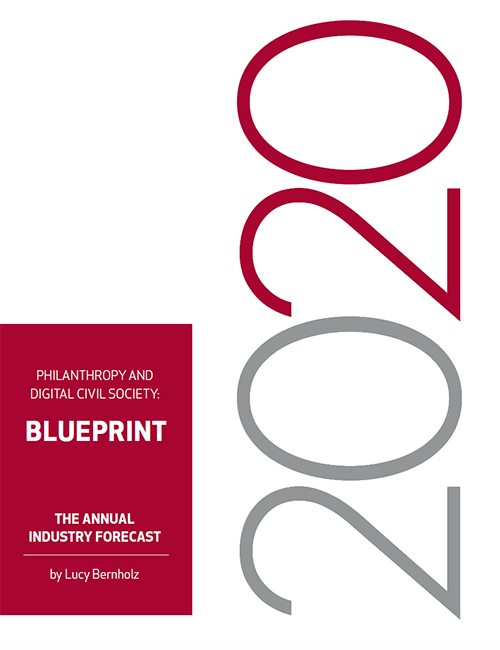THIS POST IS AN EXCERPT FROM BLUEPRINT 2020.
Imagine you climbed a high plateau and are looking out over a vast valley landscape. Spread out as far as you can see are lights, buildings, roads, open spaces, transit systems, and people. But this isn’t a city, it’s a space called digital civil society. What do you see before you? What does digital civil society encompass?
What you notice first is easy to recognize: groups of people coming together to take action—joining protests one day, raising money the next. You see familiar organizations: foundations, nonprofits, volunteer organizations, community groups, houses of worship, and political activists. There are impact investing coalitions and social enterprises, banks and mutual fund companies with vast donor advised funds, private banks, and family offices. This view doesn’t look much different than when you and I surveyed the landscape in 2010, in the opening of the first Blueprint.
Ten years ago, when you looked to the far horizon where new things grow you could make out impact investors, crowdfunding platforms, nonprofit assessment groups, corporate social responsibility officers, and cause marketing programs. Out there, we also saw “what looks like a river of energy, where new technologies including mobile phones and text messaging are being used to organize, move money, make change, and move on.” All this has moved to the center of the landscape—even political activity, over in the part of the valley where the philanthropic LLCs hover. They’re small in number but enormous in size, using their money for philanthropy, political support, and impact investing.
A decade ago the edge of civil society was experimenting with new ways to use financial resources. Now it is focused on calling out concerns about digital data.
Today, you see 501(c)(4)s, groups working on algorithmic discrimination and artificial intelligence, and a steadily growing peak of crowdfunding platforms. A hazy cloud of more than 100 “ethical AI manifestos” swirls in the wind. You notice emerging regulations focused on data protections and privacy rights, clustered around Brussels and California but starting to sprawl out into innumerable conferences, legal services, consulting groups, and funders talking about digital security and data governance. Mixed in among the new data trusts you spot active alliances between human rights, civil rights, and economic justice organizations. You see associations between activists of color, women, LGBTQ people, Muslims, labor unionists, and people in marginalized neighborhoods.
You see distributed, leaderless associations using digital tools to connect and work on everything from the climate crisis to racial justice. You also notice a new behavior: people deliberately contributing their digital data to shared databases. This includes people posting photos of birds and plants to help track ecological damage over time and people in the “quantified self” movement sharing fitness and health data. You make a note to yourself that people now contribute three types of resources to the causes they care about: money, time, and data.
You can pick out the digital infrastructure undergirding the rest of the scene. You realize that this infrastructure—internet access, cell phone service, networked printers, “cloud storage” accounts, social media, digital payment applications, voice-activated assistants, and shared document folders—is actually connecting everything else laid out before you. Every person, every organization, every quickly assembling and disbanding association you can see is connected to these digital systems.
You’re struck by a paradox. Regardless of the diversity of the groups before you, they are all relying on the same digital infrastructure. What appears to be a fragmented and independent set of activities and actors—a vibrant and dynamic space of civil society—is entirely dependent on digital systems owned and managed by companies and governments. You realize how true this is when you notice a few “dark” spots in the well-lit scene before you—these are places where governments have decided to “turn off the internet.” In doing so, they have also, at least temporarily, turned off civil society.
As you reflect on the irony of civil society organizations calling themselves independent even as they all rely on the same digital “landlords,” you notice something off in a distant corner. You realize there are a few small hubs of activists communicating in an insider-only coded patois on encrypted messaging apps over mesh networks. They’re working across national borders (and legal jurisdictions) on distributed databases. You see data trusts and data collaboratives sprouting like green shoots, as well as open collectives, privacy-protecting software coders, advocates of sovereign digital identities, and those writing rules of use for their own community’s data. This is the new edge of civil society.
Hovering over the entire scene like a string of patio lights are surveillance devices: cameras, license plate scanners, RFID readers, smart speakers, drones, building card-entry systems, as well as massive, detailed datasets of people’s digital actions. If you darken the view so that only digital traces appear, you see a moving dot for each one of the six billion active cell phones we carry with us. Enabling all of these digital tools, data, and networks are corporate providers of hardware, software, and network connections. These telecommunication and internet service companies provide the infrastructure upon which we communicate, connect, associate, and organize. Digital systems and networks underpin all of civil society today. We have reached the point where all of civil society is digital civil society.
To continue reading, download Blueprint 2020. Tweet @dgtlimpact with #Blueprint20, take the 2020 survey, and join Digital Impact on LinkedIn.

